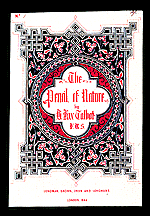

INVENTING THE CALOTYPE
William Henry Fox Talbot, the father of modern photography, was born on 11 February 1800, at Melbury, Dorset. His mother, Lady Elisabeth Fox-Strangeways was the eldest daughter of the Earl of Ilchester and Melbury was the family home.
William's father died six months later, leaving his wife and son to live in the homes of various relatives. William was educated at Harrow and Trinity College, Cambridge in the classics and sciences.
William moved to his ancestral home, Lacock Abbey, in 1827, becoming Lord of the Manor, and in 1832 he married Constance Mundy of Markeaton Hall, Derbyshire. He was MP for Chippenham between 1832 and 1834. In 1838 he published two volumes on Classical and Antiquarian Researches. He was also a gifted mathematician and his work solving obtuse mathematical problems resulted in his election as a Fellow of the Royal Society in 1831 and in 1838 he was awarded the Society's Royal Medal for his research of integral calculus and in 1842 the Society's Rumford Medal for his photographic work. In the 1850's he became interested in Assyrian script, an interest he pursued until his death. He also studied astronomy and spectrography and his analysis of minerals through flame whilst using a spectrometer was a major breakthrough of its day. His varied pursuits led him to be the first scientist to use a polarizing microscope.
William liked to travel extensively and had a gift for drawing. His drawing aids included a camera lucida and a camera obscura and it was his use of these that gave him the idea of retaining permanently the images they produced. Upon his return home he experimented by coating drawing paper with a salt solution, letting it dry and then adding silver nitrate solution. He then placed leaves and lace to the treated papers and exposed them to the sun, creating what he called a photogenic drawing and were in fact paper negatives from which positive images could be made. He published his findings to the Royal Society on 31 January 1839.
The exposure times needed when using the camera obscura were long, between one and two hours. Fox Talbot realised this time could be reduced by reducing the size of the wooden box and by using lenses that had shorter focal lengths. He had his early small cameras made by the local carpenter in Lacock Village and one is on show in the Fox Talbot Museum, others can be seen in the Science Museum, London. From 1839 Fox Talbot purchased his cameras in London from a firm called Ross of London and from Chevalier in Paris, France. By now he was using bromine paper made more sensitive by the addition of gallic acid and by October 1839 had developed the 'latent image'.
By now his exposure times were down to a few minutes instead of hours and he was able to take advantage of this by taking portraits of his family, which were some of his earliest pictures.
The first printed publication that had photographic illustrations was »The Pencil of Nature«, written by Fox Talbot and published by his own printing house in Reading between 1844 and 1846.

Cover of- »The Pencil of Nature«
- published in spring of 1844,
- 80 pages with 24 of Talbot's
- Calotypes tipped in.
It was the first book ever to be- illustrated by photographs.
|
|
|
From 1850 he conducted many experiments to perfect the reproduction of photographs as printed illustrations. To do this he used metal plates coated with bichromated gelatine and used silk to form a screen, a process that he patented in 1852.
for more information consult
The Calotype Process - at Leggat's History of Photography
Fox Talbot - Biogramm at Leggat's History of Photography
Fox Talbot (1800 - 1877) - BBC Biogramm
Fox Talbot - Profotos' Biogramm
Fox Talbot Biography - at »Talbot's Correspondence«
Fox Talbot's Complete Correspondence - Project's Homepage
Click image below to visit the Fox Talbot Museum of Photography at Lacock- Abbey, UK, the country estate which was owned by Fox Talbot and where
- he spent most of his life

